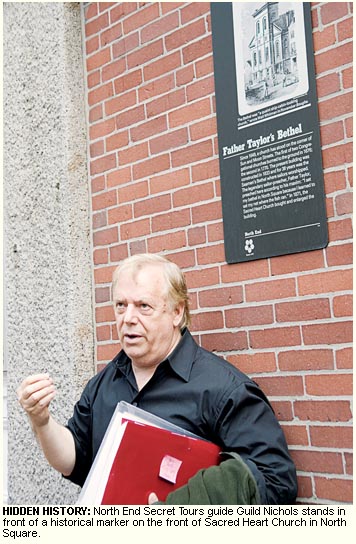
Step inside a walking tour
revealing little-known facts about Boston’s
North End
by Josh B. Wardrop
photography by Mary Lynn Burke
No Boston neighborhood attracts as many visitors as the North End—a charming, close-knit community of restaurants, bakeries and multi-generational businesses that positively bursts with history. And yet, longtime resident Guild Nichols says, visitors rarely get the chance to experience the North End in full.
“The perception of the majority of visitors is that the North End is nothing but a place to go eat Italian food,” says Nichols, who runs the North End-centric website www.northendboston.com. “Most people don’t ever explore the North End beyond a couple of blocks.”
Nichols, however, is looking to change that with The North End Secret Tour. This two-hour walking tour of the North End takes visitors to prominent area landmarks, while also telling little-known stories of the borough that provide a glimpse at the social, economic and architectural history of one of America’s first neighborhoods.
Nichols, a web designer by trade, put together the North End Secret Tour after years of simply keeping his eyes and ears open. “I read books and old newspapers, surfed the Internet, ” says Nichols. “But mostly I came upon stories by listening. Walking round the neighborhood, hanging out with all the old guys—the Wise Guys and the less wise.”
Soon, Nichols was finding interesting nooks and crannies in the streets he walked every day. He learned where the oldest sign in Boston (circa 1694) was located. He found secret passageways used by privateers in the North End’s early maritime days. He came across the narrowest house in Boston (9.5 feet). And Nichols discovered the North End had plenty of hidden secrets to share.
 One
big “secret” guests on Nichols’ tour learn
about is the diverse ethnic history of the
North End. Today, the neighborhood—with its
abundance of spaghetti joints and bakeries
full of sfogliatelle and ricotta
pie—couldn’t evoke a more Italian vibe.
Thus, few who visit the neighborhood would
realize that in the 19th century, the North
End was predominantly Irish (1840–1870) and
Jewish (1870–1900).
One
big “secret” guests on Nichols’ tour learn
about is the diverse ethnic history of the
North End. Today, the neighborhood—with its
abundance of spaghetti joints and bakeries
full of sfogliatelle and ricotta
pie—couldn’t evoke a more Italian vibe.
Thus, few who visit the neighborhood would
realize that in the 19th century, the North
End was predominantly Irish (1840–1870) and
Jewish (1870–1900).
“The Jews actually built a lot of the North End,” says Nichols. “They financed most of the construction between 1865 and 1895, and there used to be three synagogues just in this neighborhood.”
Nichols’ tour takes visitors to the few remaining signs of Irish heritage in the North End—including the birthplace of Kennedy family matriarch Rose Fitzgerald Kennedy—and those of the North End’s Jewish population, such as the faded etchings of the neighborhood’s only Star of David.
While taking the tour, tales of the year 1919 come up again and again, whether Nichols is pointing out where the wake for Sacco and Venzetti—two Italian immigrants executed for an armed robbery on highly circumstantial evidence—was held, or passing by the spot where a tank filled with 3.2 million gallons of hot molasses exploded, flooding the North End on January 15, 1919.
“It resulted in a 30-foot wave rolling through the streets at 30 miles per hour,” Nichols relates, “suffocating 21 people under a tide of molasses.”
At Copp’s Hill Burying Ground, Nichols points out interesting gravesites—such as the unmarked spot where 1,000 black men and women are buried, and the gravestone of one Betsy Darling, rumored to have been the inspiration for the nursery rhyme about Old Mother Hubbard. “She was the one with so many children she didn’t know what to do,” chuckles Nichols, as he makes note of Mrs. Darling’s 17 (!) offspring.
So, whether you’re a diehard history fanatic, or just someone who’s wondered what lies two streets over from that fabulous Italian restaurant you ate at the night before, Guild Nichols is the person to ask. But, he says, just make sure you don’t mistake him for a historian.
“I’m a storyteller,” he laughs. “I tell stories and I traffic in secrets.”
For more information about The North End
Secret Tours, refer to
listing.
back to homepage